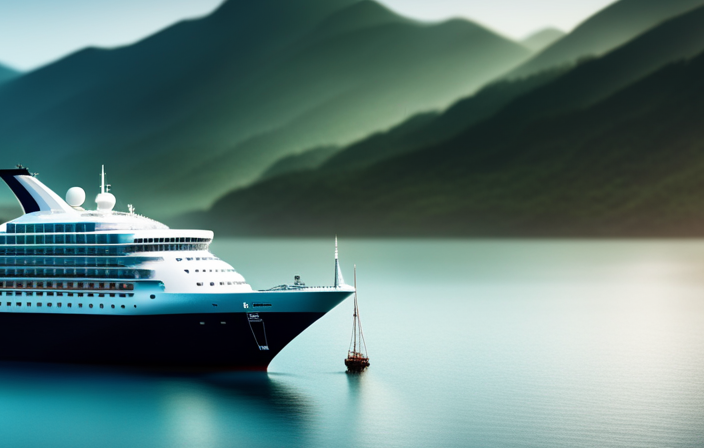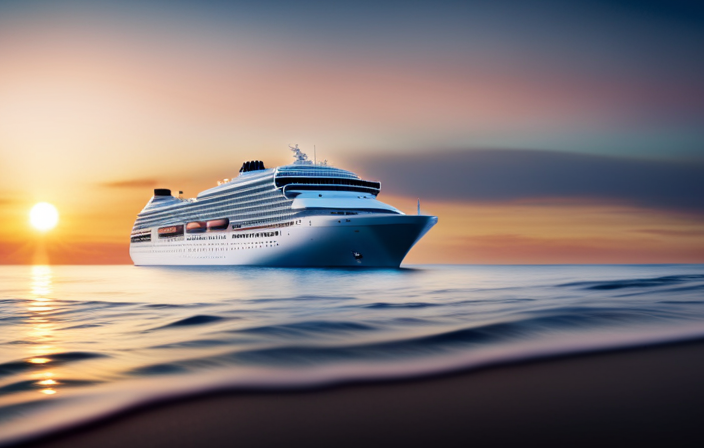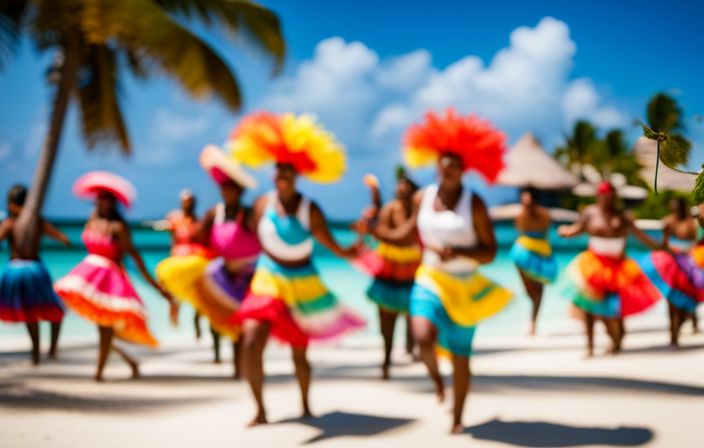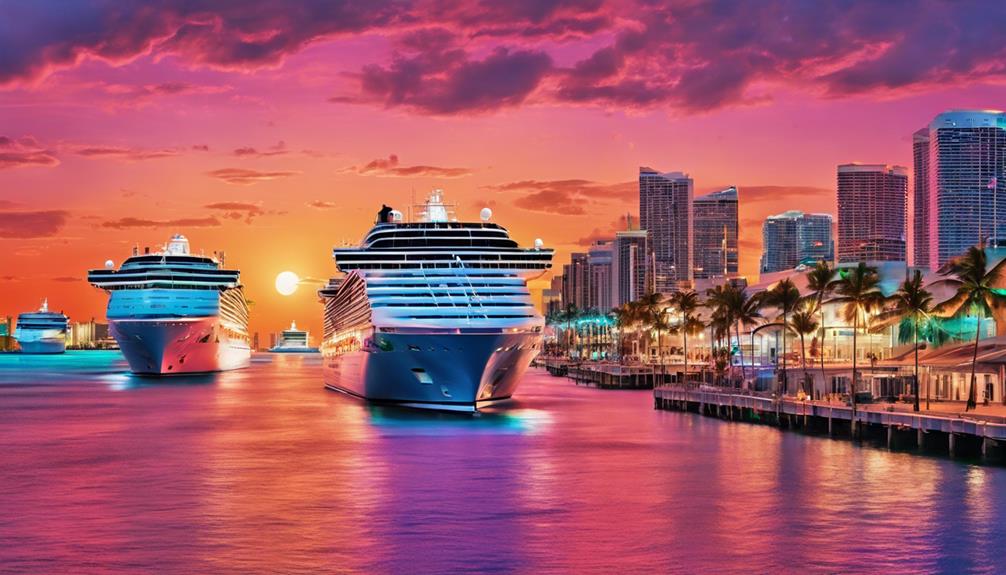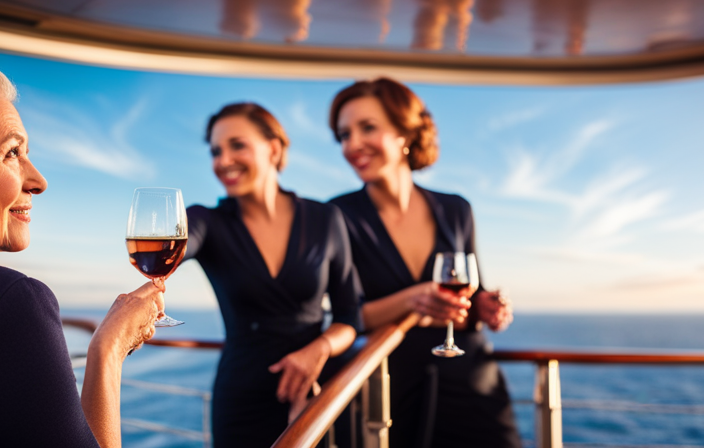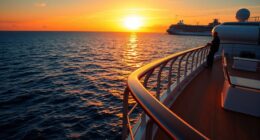Ever thought about how cruise ships supply fresh water for the thousands of passengers and crew while sailing the open seas?
It’s a fascinating process that involves advanced technology and careful planning. In this article, I will take you behind the scenes to explore the various methods cruise ships use to obtain and treat water on board.
From desalination to reverse osmosis, water storage to recycling, and even connecting to shore water supplies, cruise ships employ a wide range of techniques to ensure a reliable and safe water source.
Additionally, I will discuss the importance of water conservation and the measures taken to minimize the environmental impact of water usage.
So, join me on this journey as we delve into the intricate world of how cruise ships get water, and discover the fascinating systems that keep passengers and crew hydrated and comfortable at sea.
Key Takeaways
- Cruise ships have different methods of obtaining water, such as connecting to local water supplies when docked at ports.
- Graywater treatment systems are used to recycle and reuse water, treating and purifying wastewater from sinks, showers, and laundry for non-potable purposes.
- Water recycling and reuse systems are implemented to reduce dependence on fresh water sources and obtain clean and safe water for cleaning, irrigation, and toilet flushing.
- Cruise ships prioritize water safety and quality through regular monitoring and testing, analyzing for contaminants and maintaining optimal pH, turbidity, and chlorine levels.
Desalination: Converting seawater into freshwater through a process of removing salt and other impurities.
You’ll be amazed at how cruise ships get their water – by desalinating seawater and turning it into freshwater! With water scarcity being a pressing issue, cruise ships have been at the forefront of desalination technology advancements.
Desalination is the process of removing salt and other impurities from seawater, making it safe for consumption. It involves multiple steps, including pre-treatment to remove large particles and debris, followed by reverse osmosis.
In reverse osmosis, high pressure is applied to force seawater through a semipermeable membrane, leaving behind the salt and producing freshwater. This process ensures that cruise ships have a constant supply of freshwater, even when on long voyages.
Now, let’s delve into the subsequent section about reverse osmosis and its significance in providing freshwater for cruise ships.
Reverse Osmosis: Using high-pressure to force seawater through a semipermeable membrane, leaving behind the salt and producing freshwater.
By using the power of high-pressure, cruise ships can transform the vastness of the ocean into a refreshing oasis, leaving behind the briny depths and producing liquid gold. Reverse osmosis is the key process employed by these ships to overcome water scarcity and ensure energy efficiency. This method involves using high-pressure to force seawater through a semipermeable membrane, which selectively allows water molecules to pass through while leaving behind the salt and other impurities. The result is freshwater that is suitable for various onboard uses, such as drinking, cooking, and bathing. To engage the audience further, let’s take a look at a table that highlights the advantages of reverse osmosis for water production on cruise ships:
| Advantages of Reverse Osmosis |
|---|
| 1. Highly efficient in removing salt and impurities |
| 2. Requires less energy compared to other methods |
| 3. Produces high-quality freshwater |
Cruise ships have large storage tanks to hold the freshwater obtained from desalination or other sources, ensuring a reliable supply throughout the voyage.
Water Storage: Cruise ships have large storage tanks to hold the freshwater obtained from desalination or other sources.
Imagine stepping onto a floating paradise, where an abundant supply of freshwater is ensured through the vast storage tanks, ready to quench your thirst and cater to your every need. On cruise ships, efficient water management is crucial due to water scarcity at sea.
These ships have large storage tanks that hold the freshwater obtained from desalination or other sources. The storage tanks are designed to store and distribute water throughout the ship, ensuring a constant supply for passengers and crew. Water scarcity is a significant concern, and these storage tanks play a vital role in maintaining a sustainable water supply. They’re carefully monitored and managed to avoid any wastage or contamination.
As we transition into the next section on water treatment, it’s essential to understand that the freshwater stored in these tanks undergoes a rigorous process of treatment with chemicals and filtration systems to ensure it’s safe for drinking, cooking, and other uses.
Water Treatment: Treating the freshwater with chemicals and filtration systems to ensure it is safe for drinking, cooking, and other uses.
Once the freshwater is obtained from desalination or other sources, it undergoes a rigorous treatment process with chemicals and filtration systems to ensure its safety for drinking, cooking, and other uses, transforming it into a liquid gold that quenches the thirst of every passenger on board.
Water purification techniques are employed to eliminate any potential contaminants, such as bacteria, viruses, and chemicals. The first step involves adding coagulants to the water, which clump together impurities, making them easier to remove.
Next, the water passes through filtration systems that trap particles down to the smallest micron size. To further enhance water quality control, disinfectants such as chlorine or ozone are added to kill any remaining microorganisms. Finally, the treated water undergoes a final filtration step to remove any residual impurities.
This comprehensive water treatment process ensures that the water provided on cruise ships meets the highest standards of safety and cleanliness.
Transitioning into the subsequent section about water conservation, implementing water-saving measures such as low-flow faucets, showerheads, and toilets to reduce water usage on board is essential.
Water Conservation: Implementing water-saving measures such as low-flow faucets, showerheads, and toilets to reduce water usage on board.
Implementing water-saving measures, such as installing low-flow faucets, showerheads, and toilets, allows for a more sustainable use of water on board. These measures are crucial in addressing the challenges of water scarcity and efficient water management in the cruise ship industry.
By reducing the flow of water, we can significantly decrease the amount of freshwater consumed on a daily basis. Low-flow faucets restrict the water flow rate, conserving water without compromising functionality. Similarly, low-flow showerheads limit water usage while still providing a satisfying shower experience. Additionally, installing water-saving toilets that use less water per flush significantly contributes to overall water conservation efforts.
These water-saving measures not only address the issue of water scarcity but also reduce the strain on freshwater resources.
Transitioning into the subsequent section, rainwater collection becomes an effective method to supplement the freshwater supply by utilizing rainwater runoff from the ship’s deck.
Rainwater Collection: Utilizing rainwater runoff from the ship’s deck to supplement the freshwater supply.
To maximize water resources on board, you can collect rainwater runoff from the ship’s deck, coincidentally supplementing the freshwater supply. Rainwater management is an essential aspect of water scarcity solutions on cruise ships. By implementing rainwater collection systems, ships can effectively conserve and utilize water resources. A carefully designed system allows rainwater to be collected from the deck and directed into storage tanks for further treatment and use. This process involves the use of filters to remove debris and contaminants from the collected rainwater. Once treated, the rainwater can be used for various non-potable purposes onboard, such as laundry and cleaning. This sustainable approach not only reduces the ship’s freshwater demand but also promotes responsible water usage. Transitioning into the subsequent section about shore water connection, when docked at ports, cruise ships can connect to the local water supply for a fresh water source.
Shore Water Connection: When docked at ports, cruise ships can connect to the local water supply for a fresh water source.
To further address the issue of water scarcity and enhance water supply management on cruise ships, another method employed is the Shore Water Connection. When the ship is docked at ports, it can establish a connection to the local water supply.
This allows for a fresh water source to be utilized, reducing the strain on the ship’s onboard water reserves. The Shore Water Connection operates through a series of valves and pipes, ensuring a seamless transfer of water from the port to the ship.
This method not only provides a reliable water source but also aids in conserving the ship’s water resources for times when a shore connection is not available. By implementing this system, cruise ships can effectively manage their water supply while reducing their environmental impact.
This brings us to the next section, which explores the recycling and reusing of water through graywater treatment systems.
Recycling and Reusing Water: Implementing systems to treat and reuse graywater (wastewater from sinks, showers, and laundry) for non-potable purposes.
Maximizing the efficient use of resources, you can recycle and reuse water on board cruise ships through innovative graywater treatment systems. These systems are designed to treat and purify graywater, which is wastewater from sinks, showers, and laundry, so that it can be reused for non-potable purposes.
The process begins with the collection of graywater, which is then subjected to a series of treatment steps. These steps typically include filtration, disinfection, and sometimes even reverse osmosis. Through these processes, impurities and contaminants are removed, resulting in clean and safe water that can be used for activities such as cleaning, irrigation, and toilet flushing.
By implementing water recycling and reuse systems, cruise ships are able to significantly reduce their dependence on fresh water sources, minimizing their environmental impact and promoting sustainability. Transitioning into the subsequent section, monitoring and testing regularly ensures that the ship’s water supply consistently meets safety and quality standards.
Monitoring and Testing: Regularly testing the ship’s water supply to ensure it meets safety and quality standards.
Regularly testing and monitoring ensures that your ship’s water supply consistently meets safety and quality standards, ensuring a clean and reliable source for all your needs.
Water safety standards are crucial on cruise ships, as they’re responsible for providing safe drinking water to passengers and crew members.
Water quality testing is conducted on a regular basis to ensure that the water meets these standards. This testing includes analyzing the water for contaminants such as bacteria, viruses, and chemicals. Additionally, the pH level, turbidity, and chlorine levels are monitored to ensure the water is safe for consumption.
By implementing these rigorous testing procedures, cruise ships can confidently provide passengers with high-quality water throughout their journey.
Considering the environmental impact of obtaining and treating water, cruise ships are also implementing sustainable practices to minimize any negative effects without compromising water safety and quality.
Environmental Impact: Considering the environmental impact of obtaining and treating water, and implementing sustainable practices to minimize any negative effects
Implementing sustainable practices is crucial in minimizing the environmental impact of obtaining and treating water on cruise ships, ensuring a responsible and eco-friendly approach. To address water scarcity and comply with environmental regulations, cruise ships employ several measures:
-
Utilizing advanced water treatment systems: Cruise ships employ advanced technologies like reverse osmosis and ultraviolet disinfection to treat seawater and make it safe for consumption. These systems remove impurities and harmful microorganisms, ensuring the water meets safety standards.
-
Implementing water conservation measures: Cruise ships promote water conservation by installing water-efficient fixtures, such as low-flow faucets and showerheads. They also encourage passengers and crew members to reduce water usage through awareness campaigns and educational programs.
-
Recycling and reusing water: Cruise ships have onboard wastewater treatment plants that recycle and reuse water for non-potable purposes like irrigation and cleaning. This reduces the demand for freshwater and minimizes the environmental impact.
-
Monitoring and compliance: Cruise ships regularly monitor and test their water supply to ensure it complies with safety and quality regulations. They also adhere to strict environmental regulations, such as the International Maritime Organization’s guidelines, to minimize their impact on the environment.
By implementing these sustainable practices, cruise ships strive to minimize their environmental footprint and contribute to a more responsible and eco-friendly industry.
Frequently Asked Questions
How is the quality of the freshwater obtained from desalination ensured?
To ensure the quality of freshwater obtained from the desalination process, rigorous water treatment standards are followed. These standards include multiple stages of filtration, chemical disinfection, and monitoring to ensure the removal of impurities and the provision of safe drinking water.
What measures are taken to reduce water usage on board a cruise ship?
To reduce water usage on board a cruise ship, water conservation methods are implemented, such as installing low-flow fixtures, implementing recycling systems, and promoting passenger awareness. Energy efficient water treatment systems are also utilized to minimize water waste.
Can cruise ships collect rainwater for their freshwater supply?
Yes, cruise ships can collect rainwater for their freshwater supply. Rainwater collection is one of the water conservation measures implemented on board. This helps to reduce the reliance on external freshwater sources and promotes sustainability.
Is the ship’s water supply regularly tested for safety and quality?
Yes, the ship’s water supply undergoes regular testing to ensure safety and quality. It is monitored in accordance with water safety regulations, which include inspections, sampling, and analysis by trained professionals.
What sustainable practices are implemented to minimize the environmental impact of obtaining and treating water on a cruise ship?
Implementing sustainable desalination techniques and water conservation measures minimizes the environmental impact of obtaining and treating water on a cruise ship. Symbolically, it represents our commitment to preserving and protecting the world’s precious water resources.
Conclusion
In conclusion, the process of obtaining water on cruise ships is a complex but vital one. Through desalination and reverse osmosis, seawater is transformed into freshwater, which is then stored in large tanks onboard.
The water undergoes rigorous treatment and testing to ensure it’s safe for consumption. Water conservation measures and recycling systems are also implemented to minimize waste. It’s crucial for cruise ships to consider the environmental impact of their water usage and adopt sustainable practices.
As the saying goes, "Water, the elixir of life, must be cherished and preserved."

